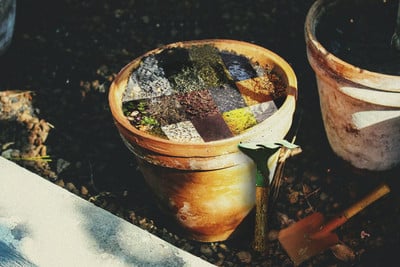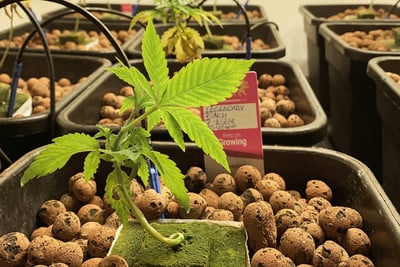.

Growing Cannabis In Coco Coir Or Peat Moss
Growing cannabis in soil alone offers good results, but soil amendments such as peat moss and coco coir can make good results great. They add structure, hold water, improve acidity, and boost microbial life.
Contents:
Growing marijuana in coco coir is a fantastic alternative cultivation style. For beginner growers and those more practised in typical hydroponics or soil substrates alike, coco coir cultivation is easy to learn. By the end of this blog, you will be fully prepped for a coco coir cannabis cultivation experiment.
WHAT IS COCO COIR?
Coco coir is the recycled and processed natural fibre from the husk of coconuts, grown mostly in India and Sri Lanka. What was once regarded as waste material, in contrast today constitutes a magnificent growing medium for cannabis plants both indoors and outdoors. With a pH of typically between 6.5-7.0, coco coir is comparable to unfertilised soil. Coco coir is available from most grow stores in 50l sacks. It's sold just like soil. But usually more readily available in tightly compressed coco bricks.
HOW TO GROW MARIJUANA IN COCO COIR
Original Jiffy pellets are made from peat, but there is also an alternative version made from coco coir. Original Jiffys have been popular with growers for decades because they contain a decent amount of nutrients necessary for seeds, cuttings, and seedlings. Both the original Jiffy and coco coir version have the same advantage: once rooted, young plants can be transplanted into virtually any other substrate.
In the last few years, most soil growers have begun blending coco coir into their own homemade super soils. Even the manufacturers of most common grow store soils recommend buffering the substrate with coco coir these days. Coco coir drains better and keeps the roots oxygenated more than standard peat-based mediums. So you already have experience cropping in soil. Why not dabble with a soil and coco coir mix before making the switch?
Most coco coir growers like to add approximately 30% perlite to the mix for best results. Although a lot of growers are also mixing clay pebbles in at a similar ratio. With equally great results. So much so, that premixed blends of coco coir and clay pebbles can be found in some online grow stores.
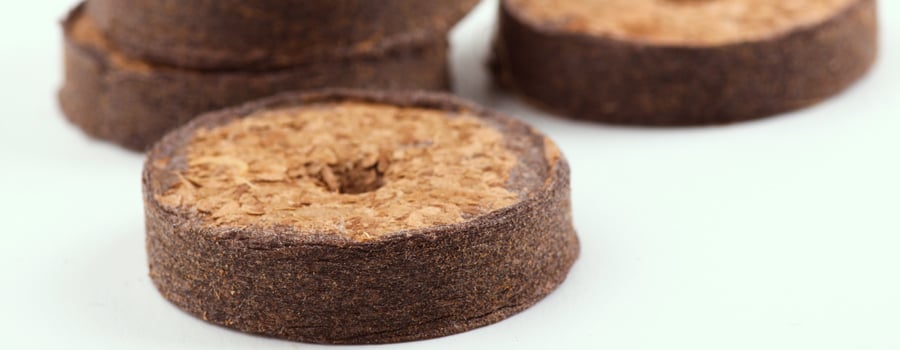
If you have coco coir in brick form, make sure to purchase a high-quality brand. Every brick will be relatively uniform. When you add 4-5l of water and leave it to soak for about 30 minutes, a consistent 9-10l of medium will be produced from each brick. Simply add perlite and mix by hand in a good-sized bucket.
Low-grade coco coir bricks can sometimes be overdried. Occassionaly they can have odd sizes. Worse, some can be really tough to break down into usable growing medium. No matter how much water you add, bunk bricks won't crumble easily.
Jiffy pellets are made from coco coir. Jiffys have been popular rooting mediums with growers for decades. Cuttings and seedlings once rooted can be transplanted into virtually any other substrate. Alternatively, you can use 1l starter pots filled with coco coir mixed with 30-50% perlite and transplant to larger containers of your preferred substrate later.
HOW TO FEED CANNABIS CULTIVATED IN COCO COIR
Watering and feeding cannabis plants cultivated in coco coir is a relatively simple transition for hydroponics growers and organic growers. Generally, hydroponic fertilisers perform better than most brands' organic soil nutrients in coco coir. Specifically, coco specific nutrient ranges are worthy of consideration.
Coco coir is more forgiving than most hydroponic mediums, but not quite as an effective buffer as soil. That being said, you absolutely can hand-water cannabis plants in coco coir as one would soil cultivated marijuana. Moreover, the grower can assess when to water by picking the pots up. Light and dry just as is the case with soil. That's your cue to water.
Coco coir unlike most soils for cannabis cultivation is unfertilsed. This is where hydro growers get to transfer their skill set. A light nutrient solution must be applied just like in a hydro crop from the beginning. The pH of your water will have to be adjusted to ensure you stay at the sweet spot for coco coir, namely a pH value of 6.0. In order to accurately keep the pH and nutrient solution dialled in, you have two options.
The simple option is to purchase high quality nutrients with pH perfect blends. Alternatively you can use standard hydro equipment. A pH meter and bottles of pH-Up and pH-Down will do the job. So you can either let the wonder nutrients work their magic or dial in the old fashioned way.
Without coco specific nutrients you will pretty soon discover, that coco coir doesn’t retain calcium very readily. Dialling in the nutrient solution can be tricky for beginners. More so with a mix and match of hydro nutrients and supplements. Iron is another missing micronutrient in coco coir that growers experience deficiencies with and often never resolve, thus reducing the final harvest. Start with the coco specific nutrients and you won’t have to troubleshoot later. Especially if you are a first-time grower.
HOW TO GROW CANNABIS IN PEAT MOSS
Peat moss also makes a useful soil amendment. Also known as Sphagnum, peat moss is a genus of around 380 separate species of mosses. Peat moss works to acidify its environment by uptaking cations like magnesium and calcium, and in turn releasing hydrogen ions. By outputting hydrogen, peat moss slowly builds bog-like conditions that can reach deep into the ground. In nature, the mosses eventually form a peat bog.
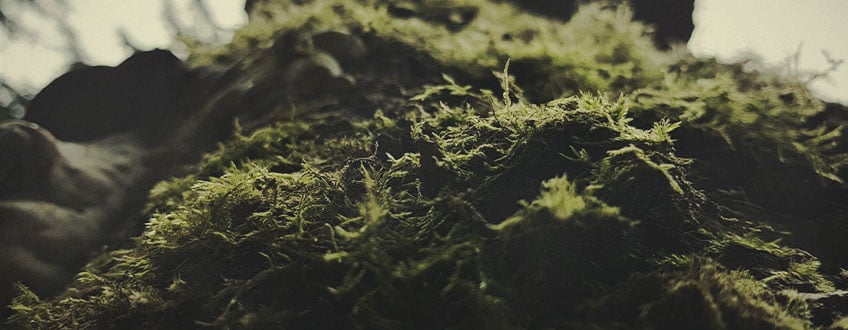
Growers need to properly prepare peat moss before adding it to a soil mix. The moss is known to be particularly resistant to absorbing water at first, and therefore needs to be well-moistened. To do so, place the desired amount into a deep tray. Spread the peat moss out across the tray and leave it exposed outdoors for several weeks. Allow dew and rainwater to soak the moss, but drain the tray as soon as the water begins to collect. If you live in a dry region, manually soak the moss before it dries out.
After several weeks have passed, add the peat moss to equal parts organic potting soil and perlite. Thoroughly mix them in a large bucket. The perlite will help to aerate the mix and keep oxygen flowing through the soil.
Peat moss will add beneficial microorganisms to the soil. Before planting, add RQS Easy Roots to enhance nutrient uptake and complement the peat moss microbes.
Taking the extra step of adding a nutrient supplement, such as the RQS Easy Combo Booster Pack, will provide your plants will all the minerals they need throughout the vegetative and flowering phases.
Once your seeds have grown into seedlings and outgrown their starter pots or plugs, transplant them into the peat moss mix.
PROS AND CONS OF COCO COIR AND PEAT MOSS
Now, let’s round up a list of advantages and disadvantages to using these substrates. Each has proven its effectiveness in specific grow setups, although they may not be effective for every operation. Use the list below to help guide you.
ADVANTAGES OF COCO COIR
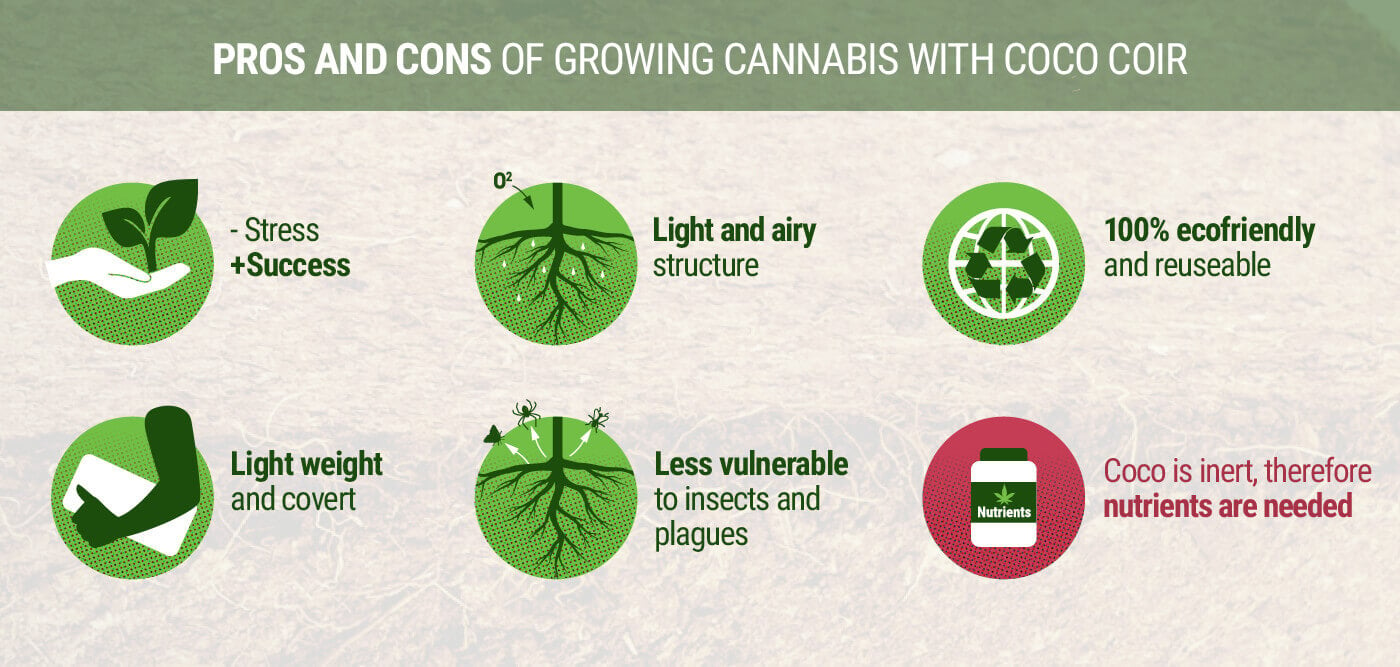
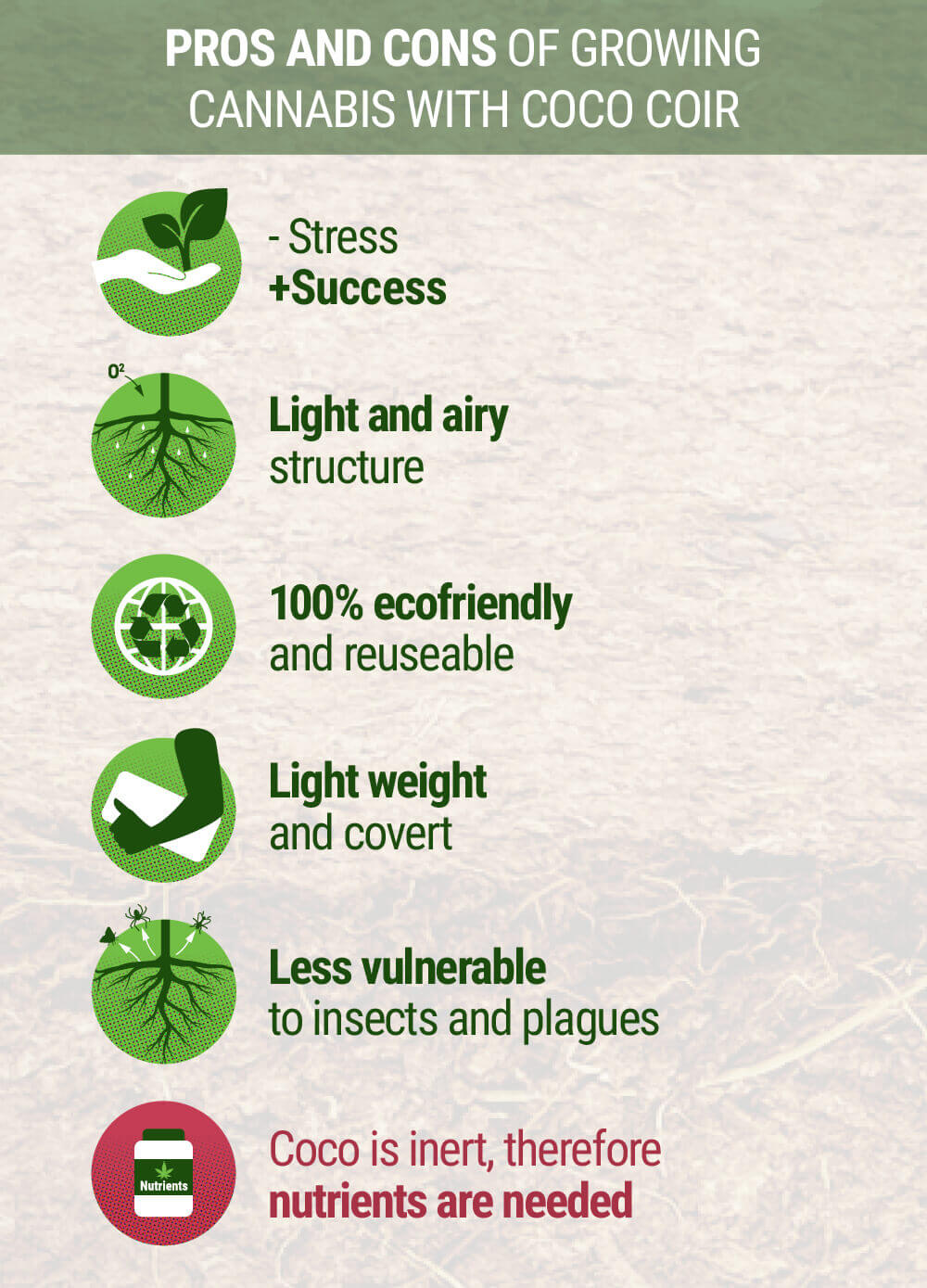
LESS STRESS MORE SUCCESS
Cultivating cannabis in coco coir is pretty uncomplicated and just like any other grow op; once you have your system dialled in, it's plain sailing. 'Nuff said.
ROOTS
Being oxygen-rich and an excellently water-retaining medium makes coco coir a really great habitat for cannabis plants' roots. In addition, coco coir retains phosphorus very well and combined with the aforementioned attributes roots will positively thrive.
100% ECOFRIENDLY AND REUSEABLE
Coco coir is a natural product and a totally reusable. In fact, by growing ganja with coco coir you are recycling and putting to good use what would have been wasted coconut husk left to rot and pile up like trash.
LIGHT WEIGHT AND COVERT
If you want to keep your growing activities stealthy and delivery costs to a minimum, coco bricks are an elegant solution. A couple of 6 packs of coco coir bricks is feather light in comparison to lugging two 50l bags of soil home from the grow store. Also, should you choose to have coco bricks delivered, they will incur far lower delivery charges and less attention than heavy sacks of soil. Perlite to mix with the coco coir can be discreetly sourced from the local garden center.
LESS VULNERABLE TO INSECTS AND PLAGUES
Root rot and nasty root invading fungi and insects are far less likely to plague the coco coir grower. Coco coir is nice and sterile and so well aerated, the roots develop almost as quickly as in advanced hydroponic setups.
DISADVANTAGES OF COCO COIR
One of the main disadvantages of coco coir is that some beneficial microorganisms don’t thrive very well in it. Trichoderma does well, but some other mycorrhizal fungi do not. Pure coco is perfect to use with pots of up to around 11 litres, but is not so good for large pots. Mixing it with perlite, as mentioned above, is always beneficial, and in large pots necessary. Always opt for reputable, high-quality coco coir brands to avoid problems with contamination or low quality.
ADVANTAGES OF PEAT MOSS
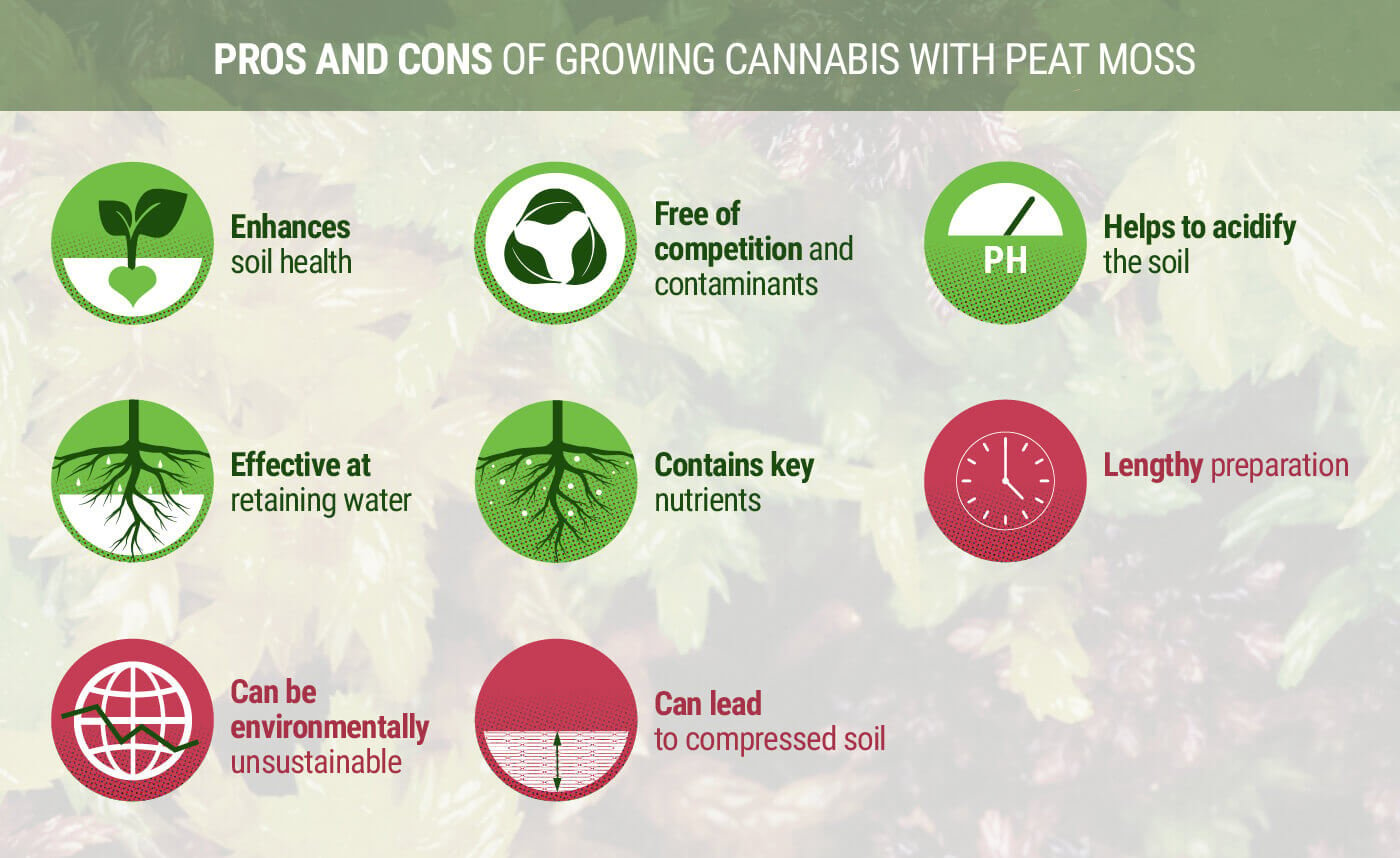
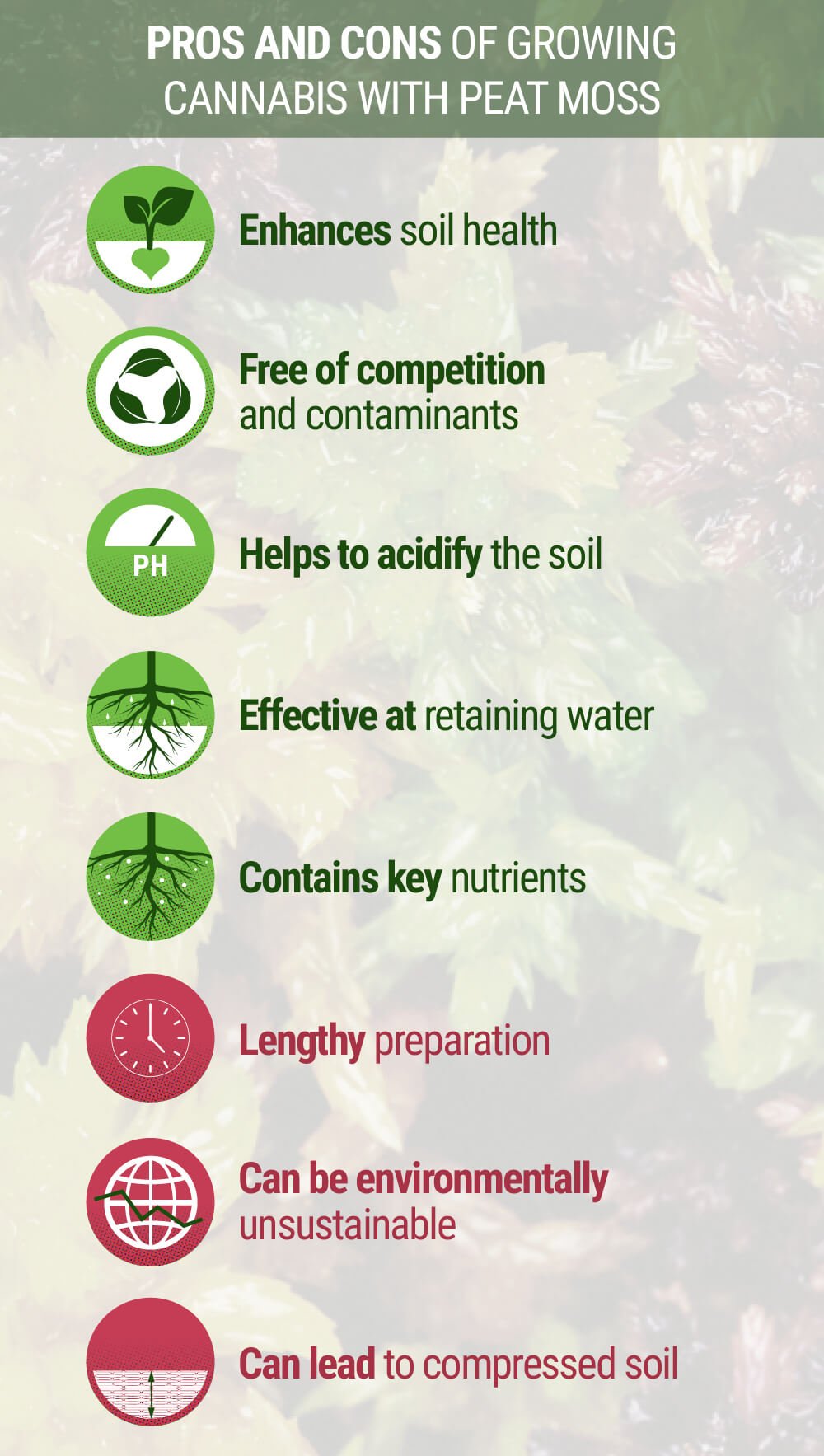
ENHANCES SOIL HEALTH
Peat moss works to cultivate a healthy community of microorganisms. Advances in the understanding of soil science have made it apparent that a diverse community of fungi and bacteria play a fundamental role in the health of the root zone. These organisms help to break down organic matter and make nutrients more available to roots. Fortunately, peat moss contains its own array of beneficial microbes.
FREE OF COMPETITION AND CONTAMINANTS
Peat moss boasts clean and resistant properties. The growing medium is void of seeds, pest insect species, and pathogens. This trait makes it a risk-free soil amendment that will keep your growing medium free of invasive weeds and damaging critters.
HELPS TO ACIDIFY THE SOIL
Soil pH is a common reason for nutrient deficiency in plants. Even if minerals are abundant in the soil, the roots won’t be able to access them if pH is outside the required range. Soil-grown cannabis thrives in a pH between 6–7. If your soil is too alkaline, peat moss will help to balance things out.
EFFECTIVE AT RETAINING WATER
Peat moss can help growers reduce their water usage. The substance is capable of holding up to 20 times its own weight in water. This makes it extremely economical, and especially useful in dry and drought-prone regions. Although damp soils can sometimes lead to mold and root rot, the aeration provided by perlite will help to counteract these threats.
CONTAINS KEY NUTRIENTS
Peat moss is a source of several nutrients that are beneficial for cannabis. One of the most prominent among them is sulphur. This essential mineral helps to form key enzymes and build proteins. Sulphur is also used in the creation of terpenes and may enhance the flavor and taste of cannabis flowers.
CONS OF PEAT MOSS
LENGTHY PREPARATION
One downside to using peat moss as a soil amendment is that it requires a rather lengthy preparation process. If you’re growing outdoors, you will need to start preparing it in early spring so it’s ready for the growing season.
CAN BE ENVIRONMENTALLY UNSUSTAINABLE
Industries commercially mine and harvest peat moss from naturally occurring peat bogs. This can sustain a substantial impact on this natural environment, which often has to be restored and repaired.
CAN LEAD TO COMPRESSED SOIL
The water-holding ability of peat moss can make it extremely damp. The surrounding soil can squash the substance together, which leads to compact soil void of air. This is a recipe for root rot and air-starved roots. However, this is only a problem when growers use peat moss in isolation—additives like perlite can help to maintain adequate aeration.




























